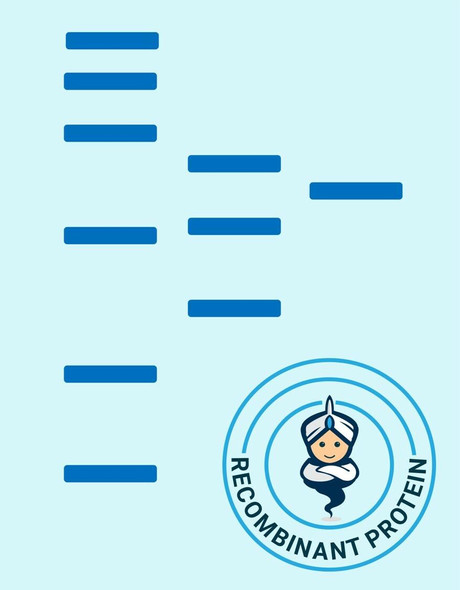Description
| Product Name: | Human NCF4 Recombinant Protein |
| Product Code: | RPPB4064 |
| Size: | 20µg |
| Species: | Human |
| Target: | NCF4 |
| Synonyms: | Neutrophil cytosol factor 4, NCF-4, Neutrophil NADPH oxidase factor 4, SH3 and PX domain-containing protein 4, p40-phox, p40phox, NCF4, SH3PXD4, NCF, SH3PXD4. |
| Source: | Escherichia Coli |
| Physical Appearance: | Sterile Filtered colorless solution. |
| Formulation: | NCF4 protein solution (1mg/ml) containing 20mM Tris-HCl buffer (pH 8.0), 0.1M NaCl, 10% glycerol and 1mM DTT. |
| Stability: | Store at 4°C if entire vial will be used within 2-4 weeks. Store, frozen at -20°C for longer periods of time. For long term storage it is recommended to add a carrier protein (0.1% HSA or BSA).Avoid multiple freeze-thaw cycles. |
| Purity: | Greater than 90.0% as determined by SDS-PAGE. |
| Amino Acid Sequence: | MGSSHHHHHH SSGLVPRGSH MAVAQQLRAE SDFEQLPDDV AISANIADIE EKRGFTSHFV FVIEVKTKGG SKYLIYRRYR QFHALQSKLE ERFGPDSKSS ALACTLPTLP AKVYVGVKQE IAEMRIPALN AYMKSLLSLP VWVLMDEDVR IFFYQSPYDS EQVPQALRRL RPRTRKVKSV SPQGNSVDRM AAPRAEALFD FTGNSKLELN FKAGDVIFLL SRINKDWLEG TVRGATGIFP LSFVKILKDF PEEDDPTNWL RCYYYEDTIS TIKDIAVEED LSSTPLLKDL LELTRREFQR EDIALNYRDA EGDLVRLLSD EDVALMVRQA RGLPSQKRLF PWKLHITQKD NYRVYNTMP |
Neutrophil Cytosolic Factor 4 (NCF4) is a cytosolic regulatory factor of the superoxide-producing phagocyte NADPH-oxidase, which is a multicomponent enzyme system imperative for host defense. The NCF4 protein is preferentially expressed in cells of myeloid lineage. NCF4 interacts mainly with neutrophil cytosolic factor 2 (NCF2/p67-phox) to create a complex with neutrophil cytosolic factor (NCF1/p47-phox), which further interacts with the small G protein RAC1 and translocates to the membrane upon cell stimulation. This complex subsequently activates flavocytochrome b, the membrane-integratedcatalytic core of the enzyme system. The PX domain of the NCF4 protein can bind phospholipid products of the PI(3) kinase, suggesting its part in PI(3) kinase-mediated signaling events. The phosphorylation of the NCF4 protein negatively regulates the enzyme activity.
NCF4 Human Recombinant produced in E.Coli is a single, non-glycosylated polypeptide chain containing 359 amino acids (1-339 a.a) and having a molecular mass of 41.1kDa.NCF4 is fused to a 20 amino acid His-tag at N-terminus & purified by proprietary chromatographic techniques.
| UniProt Protein Function: | p40phox: a component of the NADPH-oxidase, a multicomponent enzyme system responsible for the oxidative burst. Upon neutrophil stimulation, this protein and other cytosolic elements are sent to the cell membrane from the cytosol to form a complex which produces phagocytic oxygen radicals. Responsible for the downregulation of NADPH-oxidase. Alternative splicing has been observed. |
| UniProt Protein Details: | Protein type:Oxidoreductase Chromosomal Location of Human Ortholog: 22q13.1 Cellular Component: cytosol; endosome membrane; membrane; NADPH oxidase complex Molecular Function:phosphatidylinositol 3-phosphate binding; protein binding; protein dimerization activity; superoxide-generating NADPH oxidase activator activity Biological Process: antigen processing and presentation of exogenous peptide antigen via MHC class I, TAP-dependent; cell redox homeostasis; immune response; vascular endothelial growth factor receptor signaling pathway Disease: Granulomatous Disease, Chronic, Autosomal Recessive, Cytochrome B-positive, Type Iii |
| NCBI Summary: | The protein encoded by this gene is a cytosolic regulatory component of the superoxide-producing phagocyte NADPH-oxidase, a multicomponent enzyme system important for host defense. This protein is preferentially expressed in cells of myeloid lineage. It interacts primarily with neutrophil cytosolic factor 2 (NCF2/p67-phox) to form a complex with neutrophil cytosolic factor 1 (NCF1/p47-phox), which further interacts with the small G protein RAC1 and translocates to the membrane upon cell stimulation. This complex then activates flavocytochrome b, the membrane-integrated catalytic core of the enzyme system. The PX domain of this protein can bind phospholipid products of the PI(3) kinase, which suggests its role in PI(3) kinase-mediated signaling events. The phosphorylation of this protein was found to negatively regulate the enzyme activity. Alternatively spliced transcript variants encoding distinct isoforms have been observed. [provided by RefSeq, Jul 2008] |
| UniProt Code: | Q15080 |
| NCBI GenInfo Identifier: | 108884815 |
| NCBI Gene ID: | 4689 |
| NCBI Accession: | Q15080.2 |
| UniProt Secondary Accession: | Q15080,O60808, Q86U56, Q9BU98, Q9NP45, A8K4F9, |
| UniProt Related Accession: | Q15080 |
| Molecular Weight: | 39,017 Da |
| NCBI Full Name: | Neutrophil cytosol factor 4 |
| NCBI Synonym Full Names: | neutrophil cytosolic factor 4 |
| NCBI Official Symbol: | NCF4�� |
| NCBI Official Synonym Symbols: | NCF; CGD3; P40PHOX; SH3PXD4�� |
| NCBI Protein Information: | neutrophil cytosol factor 4 |
| UniProt Protein Name: | Neutrophil cytosol factor 4 |
| UniProt Synonym Protein Names: | Neutrophil NADPH oxidase factor 4; SH3 and PX domain-containing protein 4; p40-phox; p40phox |
| Protein Family: | Neutrophil cytosol factor |
| UniProt Gene Name: | NCF4�� |
| UniProt Entry Name: | NCF4_HUMAN |






